Celtic League Interceltic 1916 Commemoration and Ceremony
News from the Celtic League
The Celtic League held a ceremony and wreath laying at the Republican Plot, Glasnevin Cemetery on Saturday 26th March 2016. This year marks the centenary of The Easter Rising. This uprising was a pivotal moment in the struggle for Irish independence which began on Easter Monday 1916 with the reading of the proclamation, Poblacht na h-Eireann by Pádraig Pearse. After days of fighting on Dublin city streets and the shelling and burning of the city by the British, there were hundreds of civilian casualties followed by the executions of sixteen leaders of the Rising.
Led by the Tricolour and a piper (playing O’Neill’s march and the Minstrel Boy medley) with the flags of the Irish Republic, Irish Citizen Army and Cumman na mBan, followed by the Celtic League banner and the flags of the individual Celtic nations the procession made its way to the 1916 monument. The Proclamation was read, this was followed by more pipe tunes (Wearing of Green, Kelly the Boy from Killane, Roddy McCorley). An oration was then given by Cathal Ó Luain, Convenor of the Celtic league:
"Welcome to this interceltic commemoration of 1916 organised by the Celtic League. This monument on the site of the burial of ordinary Irish volunteers and ICA men who were killed in 1916 is a very appropriate place for our commemoration of 1916.
This monument behind us marks the rebellions in the century or so before 1916. First we have the United Irish Rebellions of 1798 and 1803. The United Irish rising of 1798 took place primarily in Wexford, Antrim and Down, while Emmet's 1803 rising was confined to Dublin. Wolfe Tone, a Protestant and the father of Irish Republicanism, was leader and founder of the United Irishmen who were a radical organisation whose slogan was to quote 'put the common name of Irishman in place of those of Catholic, Protest and and Dissenter'. Their ideals inspired subsequent movements like the Young Irelanders who rose in 1848, who gave us the Green, White and Orange tricolour which became our national flag and whose poet Thomas Davis gave us many of the most enduring patriotic songs like 'A Nation Once Again' and 'The Minstrel Boy', the which was heard on your march in.
The Fenians followed in 1867, and although their rising failed they left one of the most enduring of all organisations, the Irish Republican Brotherhood, founded simultaneously in Dublin and New York on Patrick's Day 1858. Many of the 1916 leaders were members of the IRB or were recruited in the run up to the Rising. As the Proclamation stated, quote 'the dead generations from which she receives her old tradition of nationhood'. In Ireland a cultural revival from the 1890's onwards led to the foundation of Conradh na Gaeilge (Gaelic League) and many of the leaders and activists of the time were staunch members. It was a precursor to the armed political movement.
The story of the political developments which led to the Rising is available in many places and from many sources including the excellent series produced by TG4 on the seven signatories of the 1916 Proclamation entitled Seachtar na Cásca Seachtar (the Easter Seven). A series produced called Seachtar Dearmadta (The Forgotten Seven) also illuminates the lives of the other leaders who were executed.
Also you will find on RTE the series 1916 and other information programmes on the activities of ordinary volunteers during the Rising (e.g. Brendan O'Carroll, My Family at War). There have been many publications for the centenary.
The promise of Home Rule to the Irish Parliamentary Party was followed by the Ulster Covenant in opposition to it in 1912, the founding of the Ulster Volunteers and importation of arms and the Curragh mutiny by the British Army. The founding of the Irish Volunteers came in 1913 and the famous Howth gun running followed a year later in 1914. The organisation split at the outbreak of the First World War after Home Rule leader John Redmond shamefully urged volunteers to go and fight for the British Empire.
The leaders of 1916 saw the outbreak of the First World War and the shelving of the Home Rule Bill as a last chance to strike a blow against the total Anglicisation of Ireland and for an Irish Republic. It should not be forgotten that the Home Rule Bill, accepted by the supine Irish Parliamentary Party, gave little more than powers to Ireland than those of a glorified county council. The sacrifice and executions of the rebel leaders at Easter turned the tide of public opinion and led to the Sinn Féin election victory of 1918 and consequent War of Independence.
Their ideals are clear from the proclamation you have just heard. What would they who promised to 'cherish the children of the nation equally' think of the Ireland of today where homelessness and evictions are on the increase, where a whole political class let the greed and fraud of bankers run riot with virtually no controls and then, succumbing to pressure from the European Central Bank, made the ordinary people bear the burden of austerity programmes while senior bondholders walked away untouched?
They would hardly be satisfied with a partitioned Ireland nor the treatment of the nationalist minority in the North which gave rise to a Civil Rights movement. James Connolly wrote strongly on the foreseen ill effects of partition - the creation of two confessional states where ‘a carnival of reaction’ would develop both North and South.
Pearse, Ceannt and other language enthusiasts would be appalled at the precarious state of the Irish language and remaining state of the Irish language speaking areas today. There were 170,000 odd native speakers when the Irish Free State was founded in 1922, there are now less than 30,000 in much reduced areas. Much needed funding for language planning schemes has been severely cut back. While the teaching of Irish in schools was introduced in the Free State this is the only remaining measure from the 1920s to survive the anglicising retrenchments of the 1960s and 70s which have left us with a monolingual state civil service and local authority services rules over by anti-irish mandarins.
The successful Radio na Gaeltachta was not founded as a government initiative in 1972 but by pressure from the Gaeltacht Civil Rights movement who set up a pirate station ‘Saor Raidió Chonamara’ which shamed the state into it. Nor was the thriving TG4 established as a Government innovative action. Like indeed S4C in Cymru - whose campaigners were dealing with an alien government - TG4 was wrenched from the Irish government due to the efforts of of those who climbed up TV masts, chained themselves across the entrances to the GPO and RTE and organised non-payment of licences which resulted in gaoling in some cases.
The state likes to sometimes point to the growth in Irish medium education as a feather in their cap. This is total hypocrisy. The reality is that it was achieved by those who wanted Irish medium education for their children in spite of opposition and hindrances from the Dept. of Education. Some years ago a Minister of Education even issued an edict banning full Irish language immersion in entry years, now thankfully rescinded after a considerable battle. But today new Irish medium schools are restricted to areas of population growth.
The men and women of 1916 would be ashamed at this behaviour towards the language they learned, promoted and fought for.
Our organisation the Celtic League, has aims in its constitution which reflect well those of the 1916 Proclamation:
- To support the struggle of the Celtic Nations to secure the political, cultural, social and economic freedom they need for their survival and development as independent nations
- To work towards the restoration of the Celtic languages
- To exploit our natural resources and wealth for the benefit of all
- To achieve the long-term aim of a formal association between the Celtic nations for their mutual benefit
The Rising of 1916 had varying effects on other celtic tions. 25 years ago on the 75th anniversary of 1916 we published a supplement in our CARN (issue 76) entitled 1916 The Ripples In The Celtic Tide which is still valid. Time does not permit more than a reference but this can be viewed on our website (Carn section) https://www.celticleague.net.
Looking to the future, we know that last year Scotland almost won its independence. Down the road another referendum will certainly take place and this one will be won. In Wales increasing powers will be won by the Welsh Assembly and independence sought. The Isle of Man has much autonomy and independence is back on the political agenda. In Brittany a radical movement ‘The Red Bonnets’ has emerged. The Cornish have achieved recognition as a national minority under the European Framework Convention for the Protection of National Minorities (FCPNM). We look forward to further positive developments in all Celtic Nations in the years to come!
To reflect again on 1916 it must be said that despite the sham of the Government commemorations there has been a sustained attack on the aims of the leaders of 1916 and their ideals and attempts to reinstate the shredded reputation of John Redmond of the IPP. The Government would not agree to preserve the full battlefield site in Moore St. where the leaders from the GPO made their final stand as it burned. They have now been forced to do so by High Court order, a great victory for all who campaigned for the full preservation.
Another terrible example of this revisionism is the proposal to erect a wall in the old cemetery across the road with names on it not only of those who fought for Ireland and civilians who were killed but the very British forces who sought to suppress them, who shelled and burnt the city, carried out the North King St. massacre and executed the leaders. This has been totally condemned by the relatives of those who fought in 1916.
As we stand here today in memory of those who fought in 1916 we must pledge ourselves to work to ensure that the ideals of the men and women of 1916 are made a reality despite the historical revisionist attacks on their position and actions. Let us let the world know the truth”.
Following the oration the General Secretary of the Celtic League, Rhisiart Tal-e-bot, laid a wreath, a minutes silence was observed and Lament for Limerick was played on the pipes. Pádraig Pearse’s’ poem The Rebel was read by Irish Brach Sec. Caoimhín Ó Cadhla. The ceremony concluded with the Piper playing the National Anthem which was sung by those in attendance.
Alastair Kneale Director of Information The Celtic League
Below are pictures of the commemoration:
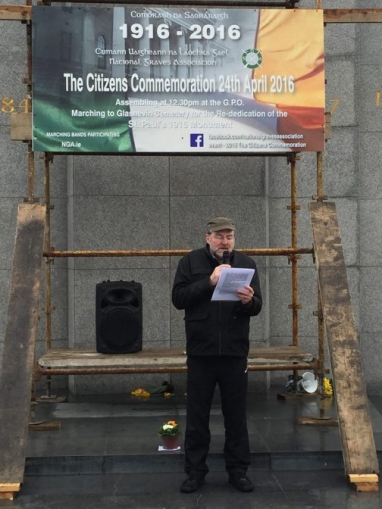
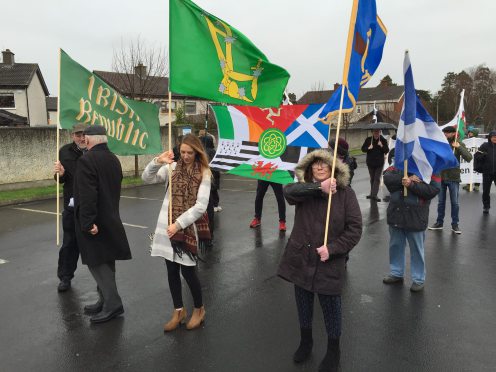
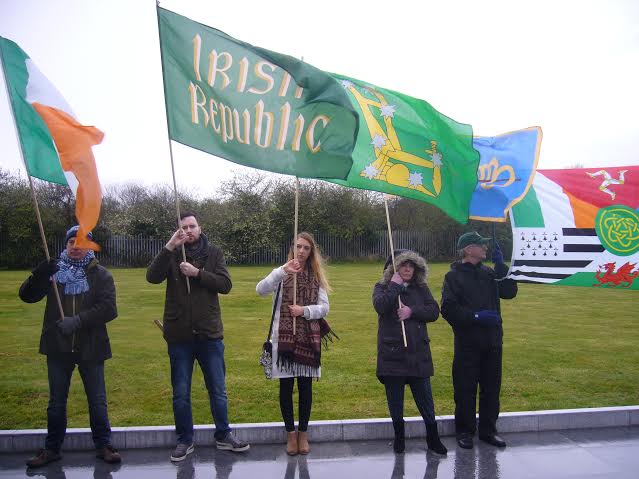
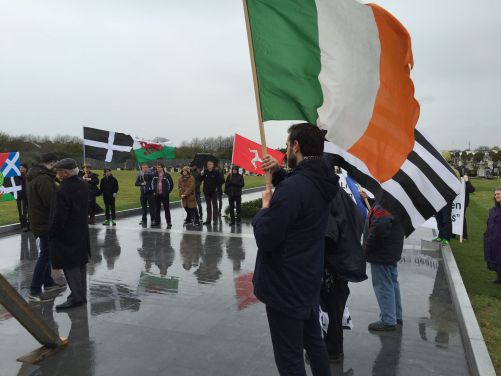
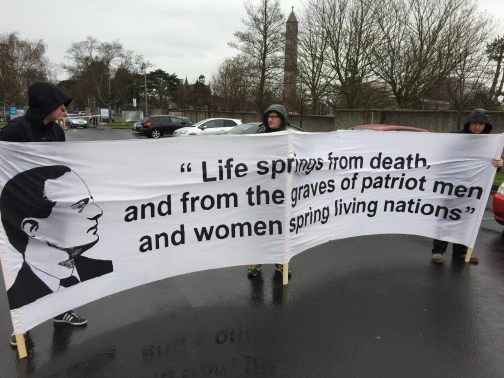

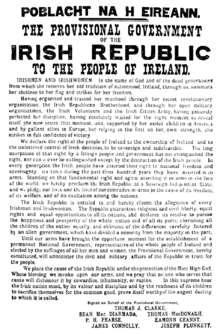
- Eibhlin O'Neill's blog
- Log in to post comments





